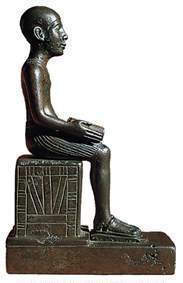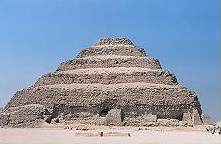Imhotep
chief minister to king Djoser of Egypt; worked c. 2630 BC
 The dates of Imhotep's birth and death are not known, but he was the chief minister to Djoser, the second king of the third dynasty, whose reign is commonly placed at 2630 - 2611 BC. Djoser is known in history as the king who brought Egypt to its first period of great cultural achievements. The first stone building was erected under his reign, bringing to an end the use of bricks for royal architecture.
The dates of Imhotep's birth and death are not known, but he was the chief minister to Djoser, the second king of the third dynasty, whose reign is commonly placed at 2630 - 2611 BC. Djoser is known in history as the king who brought Egypt to its first period of great cultural achievements. The first stone building was erected under his reign, bringing to an end the use of bricks for royal architecture.
Djoser owes his achievements mainly to his chief minister. Imhotep was a true genius in many fields, as an administrator, scribe, architect and physician. His skills as an architect are evident from the pyramid of Saqqarah (below), the first Egyptian building constructed from hewn stone and the oldest existing stone building in the world.
Imhotep's outstanding skills as a physician are not documented through any of his own writings but demonstrated beyond doubt by his status after his death. 100 years after his death he was known all across Egypt as a demigod. 2000 years later he was elevated to the status of God of Medicine, one of only two mortals that achieved divine status in Egyptian history. The Greek and Roman civilizations identified him with their god Asclepius (Aesculapius).
During the time of the Roman occupation of Egypt (after 30 BC) the temples dedicated to Imhotep in its ancient capital Memphis and on the Nile island of Philae (today's Jazirat Filah) were visited by people hoping to be cured from illnesses. The sick would sleep in the temple compound, convinced that Imhotep would reveal them a cure for their diseases in their dreams.

The pyramid of Saqqarah
home
 The dates of Imhotep's birth and death are not known, but he was the chief minister to Djoser, the second king of the third dynasty, whose reign is commonly placed at 2630 - 2611 BC. Djoser is known in history as the king who brought Egypt to its first period of great cultural achievements. The first stone building was erected under his reign, bringing to an end the use of bricks for royal architecture.
The dates of Imhotep's birth and death are not known, but he was the chief minister to Djoser, the second king of the third dynasty, whose reign is commonly placed at 2630 - 2611 BC. Djoser is known in history as the king who brought Egypt to its first period of great cultural achievements. The first stone building was erected under his reign, bringing to an end the use of bricks for royal architecture.